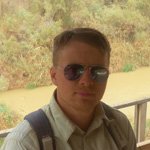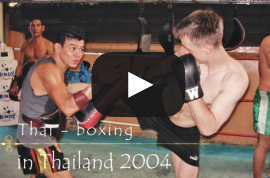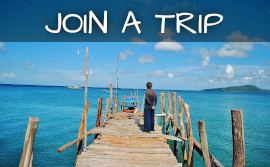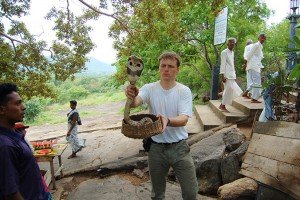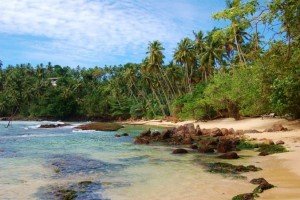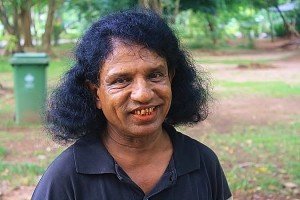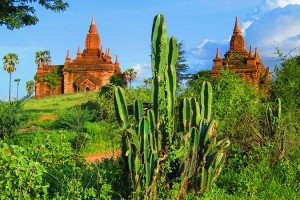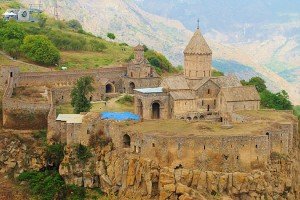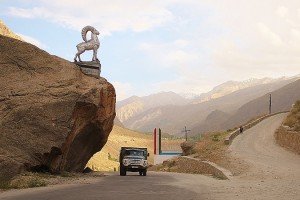Northern Thailand 2011
All travel reports are translated electronically although minor improvements are sometimes made.
Northern Thailand 2011
My trip around Northern Thailand: Lampang, Pai, Chiang Rai, “Golden Triangle” – (Mae Sai and the transition to Burma, Chiang Saen, Rob Suak, Chiang Khong and the transition to Laos), earlier Chiang Mai, Doi Suthep.
In addition to the precise descriptions of the places mentioned, these reports also include a number of practical tips, personal sensations, trivia and road trip descriptions.
For many people, my trip to Northern Thailand may seem strange because I deliberately avoided Chiang Mai. For some time the capital of the north was only my base of exchange because first I wanted to see Pai, Chiang Rai and the area of the Golden Triangle. I left Chiang Mai at the end because it was the most convenient place to return to Bangkok and future travelers also advise such a solution.

Northern Thailand – characteristics of the region
Northern Thailand is another picturesque region of Thailand, located in the mountains, among rice terraces, banana trees and waterfalls. This region offers some cooler temperatures than the rest of Thailand and is rich in all crops – including the unlucky hashish and opium. Green, transcended by the rivers of North Thailand, is located in very close proximity to Burma, Laos and south-western China. It was precisely the association of these three Asian countries that enabled the rapid development of trade, albeit with a slightly different architecture and more sophisticated cuisine. The capital of Northern Thailand is Chiang Mai, an important cultural center of Thailand and a popular tourist destination, due to its beautiful temples. North Thailand has a lot to offer but it is much less frequented than beaches in the south. In the north of Chiang Mai is a great attraction, but also mountain villages where people live their pace with very limited achievements of the modern world. In addition, it is a region of many quiet, clean and peaceful mountain stations where life flows very slowly. I also admit that in my opinion the temples of North Thailand are definitely different than those in the south and in Bangkok and I can freely describe them as a good prelude to travel in Burma and Laos. I think the sacred architecture of Northern Thailand is going in this direction. Also very popular is the Golden Triangle, which is the area of contact of three countries, although this topic will develop with the characteristics of this particular subregion.
In Northern Thailand, tours are twice as expensive than in the south, because the region is visited by 4 times less tourists. Hotel prices, food and moped rentals are roughly the same. Cheaper, however, are massages and this is a great plus. For example, a half hour massage in Chiang Mai’s open-air stupas is only 60 bhat. Meals still taste best in rural huts hidden between rice fields.

Lampang
(Description of a small, pleasant city and its attractive Burmese temples)
Lampang is a small and very pleasant town, which is often referred to as “small Chiang Mai”. The biggest attractions are the beautiful temples built by Burmese craftsmen. Other nice additions are horse-drawn carriages and calm and nice atmosphere by the river.
From the train station we took a rickshaw for only 20 bhat from one person and drove over the river, where the little tourist life was concentrated. I found the best room so far as for 250 bhat we had an air conditioned room with a private bathroom and we had a garden available. Besides drinks were included.On the first day we walked along the city streets until we reached the main intersection with the fountain.We also went to the evening bazaar where we ate traditional Thai food and thus passed us all day. We were also at a very attractive train station where the roundabout was decorated with elephants.
Next day we wanted to visit the temples and we were lucky because the lady we stayed with took us 20 km away from Lampang to show us the temple of Wat Phra That Lampang Luang . It is a Buddhist temple that was probably built between the 13th and 15th centuries and its foundations are the fortifications of the 8th century citadel. Since its construction, this temple has preserved its original form. Nor was it “improved” in terms of modern Thai visionaries, which is still surrounded by a wall and in the courtyard is the sand.Also the main temple is open on all sides, and its beautiful, multilayer roof is supported only by pillars. The temple also houses a huge gold chedi and the legend says that Buddha himself visited this place 2500 years ago and donated a strand of his hair. Wat Phra That Lampang Luang is also a magnificent sculpture that can be admired on the main entrance and the Laotian chapel in the main temple. There are also dragon carvings that run from the start of the street to the main gate. This style is preoccupied with the neighboring Burma or rather was forced because Myanmar has raided Siam so many times that today they can see their contribution to the culture of northern Thailand.

On the way back we hugged on a very nice and cheap ceramic bazaar and then returned to Lampang. We spent the rest of the day in the garden under our room. I would add that it was another, very nice evening of the traveler and his sweet blond.
The next day I wanted to tour Lampang to see all the best temples. So I rented a moped and took my women for a city tour. These were:
– Wat Sri Rong Muang ; The temple is covered with a matal roof while there is a statue of Buddha in the middle and a picture of a king in Buddhist robes, which is in Thailand. Next to it is a concrete stupa and lions in the Burmese style. The average impression was average, I saw much better.
– Wat Sri Chum ; This object from 1890 I liked more. It consists of two main buildings with Mandalay-style roofs and lions typical of Burma. The effect of this place is also exotic vegetation, but they are not Thai but typically Burmese. It takes 15 minutes. Outside there is a fruit and coconut stall which helps to overcome the heat.
– Wat Pah Fang ; beautiful garden with tall palm trees, the temple itself is not very interesting, but on the premises there is also a high, gold pagoda and impressive chapels. I advise you to pay attention to the ornaments on the chapels and to a very pleasant drum under a typical Thai roof. Very pleasant place.
– Hor A-Mok ; An old walled fort with cannons and a small Buddha statue in the middle. The presence of this place poses a question; What is this place really and why is it in such a fatal state.

– Wat Phrakaewdontao ; In my opinion, one of the best and largest temples in Lampang, also built in the Burmese style. To the entrance is the road decorated with long dragon sculptures and in the main courtyard is a huge pagoda and several other objects with roofs typical of the Burmese architecture. (I think my photo gallery of Yangon and Mandalay will best show this style). There are also several elephants and other animals worshiping the Buddha and the Burmese dragons. Also impressive are huge, massive gates with dragon sculptures. There is also a school for monks.
– Wat Pongsanook Tai ; is a small but beautiful temple consisting of a main building at the height of the street and a temple complex on the top surrounded by a wall. Downstairs is a Thai temple with white pillars and typical roof architecture. This object differs, however, from the fact that at the ends of roofs instead of hooks facing up are the Burmese dragons. On the hill next to the white wall there is a gold pagoda and some small objects covered with mosaic. It is an exceptionally beautiful place with many attractive details and skilfully integrated vegetation.
Lampang on the moped is easy to explore because the town is small and the map itself leads to the place.That evening we also stayed in our beautiful garden, spending time on tea and writing a diary. Lampang is in my opinion a very good addition to a Thai trip for 2 days, conveniently located between Sukhotai and Chiang Mai.
Transportation from Lampang to Pai
We went to Pai with Chaing Mai but deliberately did not stay here because Chiang Mai wanted to leave at the end to return to Bangkok.
From Lampang to Chiang Mai we rode a good bus, 2h for 67 bhat. Then in Chiang Mai we took a minibus to Pai-3h for 150 bhat. This stretch was beautiful because the road was full of bends and nice mountain views.

pai
Pai is a popular mountain tourist attraction. The village itself is very nice and well organized, you can eat well and find a cheap room. I found a place for only 150 bhat a night with a shower for our three. I admit that the prices are really good here. But what is beyond Pai, beautiful nature, vast space full of rice fields and clean air. Not far from Pai is a canyon, several temples and a Chinese village surrounded by vast valleys. You can also find hot springs in magnificent gardens, elephant villages and roadside pubs serving rice at a nominal price. This makes Pai a very popular place and its only drawback is unfortunately its popularity alone. Sometimes the town gets crowded but of course it’s not the second Bangkok. I recommend a portion of cooked rice dumped with coconut milk with mango slices on top.
As usual I was well organized so I hired a moped and for three beautiful days I toured the whole area and saw the most beautiful places. Early morning I hired a moped for only 100 bhat per 24h and drove through the fields. Unfortunately, it was raining, so we stopped by the tree at the local host to pet their dogs and when it cleared up we went up to the Wat Mae Yen temple. The property was rather average and needed refurbishment, but after all the other temples I saw in Thailand this was not the most important. There were two temples, one with the altar of Buddha and the other with the lying Buddha. There was also a small souvenir stall and gold stacks. The beauty of this place was its seclusion and the scenic views of Pai and the surrounding area. Then again following the narrow road through beautiful views of clean air, we reached the hot springs of Tha Pai , where we spent most pleasant days. The hot springs were located in an exotic garden and we were all day surrounded by banana trees, papaya trees and palm trees. At the same time, the attractive tea gave me a cup of tea, and I soaked myself and floated from the cooler to the warmer part of the pool. The entrance cost only 100 bhat per person. In the meantime a warm tropical rain fell several times, but it did not matter. Also, the rain and dripping drips from the palm trees to my hot springs were very pleasant. Then we got on our moped and drove for dinner to the elephant camp . We ate a couple of portions of fried rice and we admired the beautiful open air and the elephants in the pasture.Also on the way to Pai I have been standing many times to take pictures of landscapes.

The next day we went again for a beautiful moped tour. Coming through the empty fields and peaceful, picturesque landscapes we reached the temple of Wat Nam Hoo . The beauty of it was that it was located on the water, and from the platform you could feed the fish. Then we had a long but very nice ride to Mor Paeng Waterfall . Earlier, however, we stood in the Chinese village of Santichon . I admit that it was a very nice but also very commercial village full of shops where Chinese tea sets were sold and many other chinese household items. The time over the waterfall was very successful. I would best describe it as many huge boulders stacked on top of which a strong stream of water flowed. This is a very good place to relax.Our return to Pai was also very pleasant as we were driving all the way from the hill and therefore drove off the engine. On the way we also stopped in a bamboo hut for dinner. The food was good but the exotic setting of this place was great.
Upon our return to Pai we went to Pai Canyon . Grand Canyon is not but the views are beautiful, so I would heartily recommend this place. On the way back to Pai we also stopped to admire the plenary, also at the large golden pagoda visible from the main road.
The time spent in Pai and its surroundings was a very pleasant experience.
While in Pai, I also advise you to look at the “house upside down” which is located at the entrance to the town.
Transportation to Chiang Rai
First bus 3,5h to Chiang Mai and then almost 4h to Chiang Rai. The second part of the trip was difficult because we were driving an old uphill bus that barely managed. This trip was not pleasant. I felt I had enough.

Chiang Rai
Chiang Rai is a small town in the north of Thailand, which “does not see” too many tourists. This is the direction for those who have gone through the standard tourist route and Chiang Rai is something more.This small, charming town is a very good base for the Golden Triangle and tours to mountain villages and especially one of the most interesting temples.
We went to Chiang Rai late in the evening but rather quickly found the room. We stayed at Ban Bun Doon Guest House for only 200 bhat and had even hot water. The next day we went to visit and in less than one day quietly passed all Chiang Rai. First we saw a gold, intricately decorated clock tower , which is located on a small roundabout and is in my opinion a symbol of the city.
Then we went to Wat Phra Kaew where the Emerald Buddha once stood, which can be seen today at Wat Phra Kaew in Bangkok. I think this temple was the best of all. There was an altar with a statue of Buddha and paintings and paintings in the center. Attention was also drawn to red pillars with golden patterns, decorated furniture and a number of other religious objects. The entrance to the temple itself was surrounded by exotic greenery and dragon sculptures leading directly to the main gate. Next to it was an alley covered with greenery where one of the wooden houses housed a museum. This place displayed especially beautiful Buddha statues, dragons, Ganesh and many other objects made of teak and precious stones. There was also a swimming pool that was home to turtles and turtles. One of them was particularly enormous, hiding behind the bushes floating on the water and enjoying the eyes of the visitors. In many temples throughout the “Buddhist world” there are pools where the monks cultivate turtles and each time it is the most relaxing part of the temple. Next to the pool was another large chapel and a gold stupa, where the faithful lay lotus flowers in front of the Buddha. The Wat Phra Kaew Temple in Chiang Rai was a very pleasant place, and the rich and skillfully integrated vegetation and turtle pool provided an even better expression.

Walking through Chiang Rai we reached a vegetable market where some women were dressed in traditional costumes for mountain villages. On the way to the hotel we counted two more temples. The architecture was exactly what I described earlier, in this case it was a combination of classical temples we know from Bangkok but with a strong influence of the Burmese style. In the courtyard of one of them was a large monument of golden, greasy Buddha, which I saw earlier in China. Another had a very large, carved red gate, and a water-rich vegetation behind which the dragons on the stairs led to the main chapel.
Near the golden clock tower we sat in one of the many pubs for roast duck with roast and it made us so lazy that we had to take a nap. Especially considering the tropical, hot climate of Thailand was necessary.After a nap we went to the tourist office of the PDA and the Hilltribe Museum on the top floor . As I could have expected it was a show of paintings and photographs depicting these people and an overwhelmingly large display of household objects. All of them were of course hand made and made of what was available in nature. We have also been told about the exploitation of mountain tribes for mass tourism, although it was ironic that the person who told us about it wanted to take us on a trip for an exorbitant price of 2200 bhat per person. The museum itself and the cultural center were a good introduction to our day trip later, and a 50 bhat ticket included a cup of tea in the downstairs restaurant.
For the rest of the day we strolled through the city, escaping from the heat in the temples and in the evening we went to the night bazaar where the show took place and there was plenty of money to spend on something interesting but rather unnecessary.
Then tired we returned to our very low class room which however provided the required minimum. That evening the monsoon sprang up for good and the water in some places stood on its knees.

Day trip from Chiang Rai
The next day we went on a tour of which we had to see mountain tribes, natural beauty and the White Temple. Despite the rain all day we made a great trip and the trip cost us 900 bhat from the person including the shuttle, which was most important.
White Temple located 10 km from Chiang Rai is a new project that was not completed in 2011. Still, because of its sophisticated style, it has become very popular at short notice. The White Temple is covered with exquisitely crafted elements which give the impression of a focus and sunlight directed at each side. At least this is my vision of this purely white building, but others describing it differently could also be right. At the entrance there are warriors with swords and arches in the pattern of elephants, and beyond, there is a main entrance. Although the skeleton itself is built in a very similar way to those in Bangkok, however, the richly decorated white ornaments diminish its original shape. The temple garden itself is also pensive. Just behind the lawn and small ponds is a place where you can see the hands of people standing above the ground. This is a symbol of sinful men who are drawn to hell and are trying to get to the surface. There was, of course, the symbol of the Buddha, but very unusual, the paintings on the walls of the burning World Trade Center and many black characters from American horror movies such as Terminator, Alien, Freddie Kruger and more. Next to them were painted people in the clouds, who were walking in the direction of the Buddha. The message was to break free from the evil world and to find peace and solace in the teachings of the Buddha. The White Temple was beautiful, had a deep message and also required time. Outside the territory of the temple were also sculptures of skulls and skulls as ornaments of fences.

Then we went to the Karen village located on the river where we rode half an hour on the elephant (300 bhat). This village is just off the road, it is very popular and I would not call it “cut off from the world”. On the other hand it is a very pleasant place among the rice fields and the elephants are also very nice but otherwise it is pure commercial. I think it is best to come here to see the huge Tiger Python ( Molurus Bivittatus ) who lives in one of the nearby families. He is monstrous and the fact that I could stay with him for some time has made me miss the stingers I keep in my bedroom.
Then we crossed the village of Yao . It was a small settlement consisting of several wooden houses surrounded by banana trees. Unfortunately, nobody was there because they all worked in the rice field, so we went to the Akha village which was a more interesting experience and where we had contact with the people of this tribe. Akha village was situated on a hill, surrounded by exotic vegetation and near the river.We dined here on a banana leaf in one of the primitive wooden houses covered with palm leaves. In the backyard of the children were dancing on bamboo swings and women dressed in traditional costumes and clothes. In one of the homesteads I also helped to make butter from goat’s milk, in a popular for this purpose, 19th century cube.
Then walking about 40 minutes through banana trees, papaya trees, palm trees, and watching nature and people at work, we reached the village of Lehu . This village was also very pleasant and authentic in its expression. First, we went to a small museum of hill tribe art. There were mainly primitive tools of everyday use and tribal art, and the clay building in which the museum was located fit very well with the rest of the village. Then we were in the main village where there were of course wooden houses, bamboo and leaves and pigs playing with the children. Unfortunately, I noticed here the modernity, that is poured concrete and some houses covered with sheet metal which took the originality of this place.

Our last occupation was a 1km march from Lehu village to Huai Mae Sai waterfall. Our guide was a very poor man from the village who led us up the hill. The road to the waterfall was an adventure in itself, as we had to walk in winding, narrow paths and sometimes had to climb and jump over broken trees and boulders. The waterfall gave me great pleasure as it was beautiful and exuberant. It consisted of two floors and was surrounded by vegetation and rocks. So I was swimming in a natural pool, and the cold water gave me so much energy that I climbed the slippery rocks to the top.
After all, tired but happy we went back to Chiang Rai.
Golden Triangle
The Golden Triangle is a town in the north of Thailand called Sop Ruak, which borders the three countries of Thailand, Laos and Burma. However, for the purposes of tourism by Thailand, the Golden Triangle is a northern area between three townships: Mae Salong, Mae Sai and Chiang Saen, at the confluence of the Ruak and Mekong rivers, which actually maps the triangle. The Thai government has defined the area of the Golden Triangle in this way, suggesting that it does not go beyond Thailand, but it is also true that the “Golden Triangle Cities” are also border towns in Laos and Burma and also in Vietnam. It can be said that the name is quite ironic because the true meaning of the “Golden Triangle” is derived from the largest in the south-east Asian region of opium and heroin. It was not until recently that most of the drugs came out, but at the beginning of this century, Afghanistan emerged as the world’s largest heroin producer.
In Thailand itself, however, real heroin and opium factories are “invisible”, while some Thai governments advertise it as a tourist attraction where you can see the entire product process. Besides, the Golden Triangle is also a different culture and architecture of Thailand, different climate and a completely different adventure.

Road to Mae Sai
My goal was to go to Mae Salong first, but after transferring to Ban Basan, I could not find the transport because the shared taxis departed only when they were full but unfortunately there were no passengers.So we boarded a bus from the main road and drove to Mae Sai Station. From the railway station to the border with Burma is still 4 km away so we took a shared taxi for 15 bhat per person.
The whole trip, directly from Chiang Rai to Mae Sai would take around 2h and cost about 40 bhat.
Mae Sai
(Description of the town, its attractions and its popularity due to the extension of the Thai visa)
It is a border town with Burma and at the same time the northernmost city of Thailand. The straight road leads straight to the border, which makes it impossible to miss a huge blue building leading directly to Myanmar. When we arrived, in several places there was a flood so I had to choose a more expensive hotel and in the dry part of the town I was able to find a low class room for 250 bhat. Besides, Mae Sai is a network of huge number of shops located on both sides of the street. There are many paintings and especially sculptures; Thai, Burmese and Chinese. It is also a great place to buy t-shirts from all over the country and one general from the Golden Triangle. When it comes to pubs I would definitely recommend desperate for renovating side streets where you can dine for a few bhat. I also recommend a hairdresser for whom the equal cut of European hair was not a problem, because every day he has to deal with rigid asian.

As a day’s stunt we climbed the tallest mountain on the Thai side where the temple was, according to me, a combination of Buddhism and Hinduism. There were many monuments of Buddha and Ganeshy, an elephant statue and even a statue of a great scorpion. The whole was obviously surrounded by orchids and other exotic plants, although I think the point of the program was the view of Burma and its golden pagodas. About a month and a half ago I came back from here and now I was going to go there again. This time to Tachileik border town.
After a good night’s sleep in our very bad hotel, we went to Tachileik in Burma early in the morning.
Mae Sai is also very popular because of “visa tours”. To get a cheap Thai visa with a two-week stay permit you have to go to Burma for a while and then just come back. A new Thai visa costs only 500 bhat. This is a perfect layout that makes the tourists happy because they can get a cheap visa without a problem, and Thailand and Myanmar take a large part of the national income.
Transportation from Mae Sai to Chiang Saen
Upon our return from Burma, we wanted to go to the next Golden Triangle, Chiang Saen, traveling along the border with Burma and Laos, but unfortunately it was Sunday and there were no direct buses. So we took a shared taxi for 15 bhat to the Mae Sai station, 4 km away from the town, and from there tragic bus we drove to Mae Chan. This part of the trip took 0.5h and cost 25 bhat. From Mae Chan we also took a bad bus to Chiang Saen (0.5h-30 bhat).

Chiang Saen
(My favorite town in the Golden Triangle)
Chiang Saen is another very nice little town on the Mekong, overlooking Laos on the other side of the river.This small town is also famous in Thai history as the place where the kingdom of Lanna was founded in the 7th century and then transferred to Chiang Mai.
Quite quickly I found a room for only 200 bhat per night, which is probably not tasted. On the bank of the river were transport and cruise ships from China and on the evening the promenade turned into an open-air restaurant. We came here in the evening for a fresh grilled fish, previously served with a thick layer of salt and stuffed with bamboo, perhaps to kill the smell of the Mekong. Boat trips to Laos, Myanmar and China in Yunnan Province were also offered. If anyone wants to get to the Laos border, traveling along the Mekong to the east is only 68km.
First we saw Wat Chedi Luang or a beautiful temple next to the museum, which is set on pillars without walls and where there is a very attractive face of the golden Buddha. The main area for prayer is kept in red, which matches the color of the bricks, and the altar and religious symbols around them work very well together. Next to it is a large brick stupa wrapped in orange cloth and covered with grass and a souvenir stall. This area is also a popular meeting point for men playing football and drinking tea. Wat Chedi Luang was my favorite place in Chiang Saen. Next to the Chiang Saen National Museum, unfortunately, it was closed due to renovations. I just walked from the outside to see from the exotic vegetation the great head of the “lying” Buddha from the fourteenth century. Then we went to the ruins of the ancient city of Wat Pa Sak (entrance 50 bhat). There were several antique objects in the park, similar to those I had seen in Si Satchanali and Sukhotai. These are usually ordinance holes with broken pillars and many Buddha monuments, nicely incorporated into the green palms and banana trees.

In Chiang Saen, there are several other, often irregularly scattered stupas, such as Wat Pong Sanuk .
Unforgettable and also very relaxing was the local bazaar where there were local delicacies and abominations. For example, frogs, fishes that look so terribly exorcist, insects and pigs are sold here. There were also turtles, but fortunately only for the Thai to keep them in their garden ponds. At the entrance there was a nice and very expensive tea room and outside the grilled chickens. There is one more dish in Asia that I have never eaten because it disgusts me. These are very popular, densely packed eggs diced on a stick. I do not say, I like ducks but punching babies on a stick is a bit too much for me.
There are two interesting temples along the river, which may be interesting to fill in at least an hour. Both are made with great care and both have well-made monuments of elephants and lions in the Burmese style.
Chiang Saen warmly recommend.
Sop Ruak (Golden Triangle)
Sop Ruak is really a town of the Golden Triangle, because in this small village at the confluence of the Mekong and Nam Ruak rivers the borders of three countries are touching: Thailand, Laos and Burma. We came here on a moped from Chiang Saen (only 8km) and it was a nice, relaxing trip along the cornfields and the coast. As I could have hoped, Sop Ruak is just a big souvenir shop, mainly from Thailand and Laos.In addition, the Thai were striving to build an object that can not be called the temple. There was a huge golden Buddha, huge elephants, a gate and marble observation deck and a few golden ornaments. In my opinion, the whole was a monument to kitsch and the view of Laos was exactly the same as Chiang Saen.In my opinion, the only reason to come here is just to say that I was here. On the other hand, the time for this place is enough so you can take a chance, and by the way do cheap shopping.

Near Sop Ruak is also the House of Opium where you can see the entire process of drug production, the product from which the Golden Triangle is famous. When I was here was unfortunately closed because of consolation I broke up papaya growing wild in the field and returned to Chiang Saen.
Transportation to Chiang Mai
From Chiang Saen local bus to Chiang Rai where we ate delicious dinner in traditional Thai style. Hike to Chiang Mai took us 3h. Shorter than the reverse because it was from the hill.
Chiang Mai
(Description of the city and its beautiful temples and attractions)
Chiang Mai is the capital of the north, unmatched more relaxed than Bangkok and more friendly climate as it is cooler. Its greatest assets are its beautiful temples and the whole area of the old town, but also small shops, bookshops and secluded cafes. There is also a cheap outdoor massage and secluded cafes and interesting zoo.
As a tour outside the city I would definitely recommend Doi Suthep.
Upon arrival at the well-known train station we took a shared taxi and for 60 bhat for us both got to the Old Town. Our home was Daret`s House where for a double room I paid only 220 bhat. On the first day we only found ourselves in the area, ie we walked among the walls of the Old Town and the surrounding moat.

The next morning we went to visit the most impressive temples. We saw them a lot and they were all beautiful and all of them were the same. In each of them there were statues of Buddha, high stupas, gardens and statues of lions and snakes in front of the temples. Here are some of the highlights:
-Wat Pra Singh ; from 1345, one of the most famous and architecturally typical of Lanna style.
-Wat Chiang Man ; that is to say, the oldest temple inside the walls of the Old Town. It was built by King Mengrai in 1296. By the way, King Mengrai was the founder of Chiang Mai. Inside the chapel is a “crystal Buddha”, which according to legend has the power of attracting rain.
-Wat Phan Tao ; It is not so old and antique but has a beautifully built, main teak chapel. A profiled, multi-storey roof, with golden hooks facing upwards, is also a great asset. The main door is an interesting relief and inside there is a pretty chapel.
-Wat Chedi Luang ; I think the biggest and most beautiful temple inside the walls of the Old Town. The first object I saw at the entrance was a typical temple that combined the style known to all of Bangkok with Burmese influences, in the form of dragons at the entrance. In the middle is a typical Buddhist chapel with prayers in the middle. However, the best part of Wat Chedi Luang is the extremely large and massive chedi of 1441, which was destroyed by fire or earthquake. The damage is so great and so impressive, especially since after the restaurant work we can admire the statues of elephants and dragons. The reconstruction was done so that the huge chedi still looks ruin though the details are done with great care. Unfortunately, you can not climb the stairs to the top, but only to observe from a distance. Around the chedi there are many smaller, smaller objects, and one that I especially recommend is the great statue of the greasy Buddha, which was made like a cartoon character.

From the Wat Chedi Luang Temple we went for a ride on the luxurious, off-road Honda for only 100 bhat.Our layout with the driver was that in exchange for us going to some beautiful shops and galleries, then we will see two more temples outside the walls of the Old City and pay only 100 bhat. This was the most convenient way out of the situation and a great way to spend the day.
We were in a beautiful jewelery gallery where the aquariums were exceptionally expensive, but also great jewelery. Noble metals were combined with noble metals in the shape of animals and ships and there were many motifs inherent in the form of necklaces. From what I’ve seen, Europeans are a rather poor race.They just come to see. The best customers were the rich of the Arab Peninsulis, who got rid of cash with the speed of flowing oil.
The other place was a silk factory , which was made of two parts. In the first building, women worked on machines of several types. Some recovered the silk from the cocoons and plucked it into the thread, while others twisted the wheels and pedals, weaving the material. In the second building was a luxury shop where a pair of silk socks cost $ 25 and a $ 60 tie. There were also suits, shirts and carefully selected for this work, charming Thai. I understand that it was Thailand so it was cheaper than in Europe, but as for local conditions it was another store from which “liquid gold”.
Our last place was a gallery of art , mostly Indian and Persian. There were wonderful carpets, silk-woven paintings, antique teak furniture and elaborate figurines. My attention was drawn to the teakwood table and four chairs, rubies and white marble, the only “GBP6500”.

Then we went to our last two temples that day outside the walls of the Old Town:
-Wat Jet Yot ; This is the temple I would best describe as a row of white stupas of different heights. The guide said that this temple is similar to the temple of Magabodhi in Bodhgaya, India. Next to it was a traditional temple where there were very many monks on that day. To sum up the stupas themselves were worth seeing although for someone who had already traveled all over Asia it was nothing new.
-Wat Suan Dok ; In my opinion it is not the most beautiful I have seen. This is a band of several chedi with bare brick walls. The attention should be paid to the bas-reliefs of the Buddha located on the walls of the temples. Some of them have no heads, but it is a nice addition to the ruins. Wat Suan Dok is also home to a Buddhist university and meditation courses.
The next day in Chiang Mai we went to the zoo . For the tickets I unfortunately had to pay because the price of the white man is about five times more. The zoo was very interesting. There were lots of cats, koalas, monkeys, elephants to peck and panda for a separate fee. Unfortunately maintaining pand and paying for china to have them cost so much that watching them is expensive. Last time I saw pandas in China in 2006.There were a lot of animals in the zoo but unfortunately it was a problem because the zoo is so big that buses run there and if you do not have the luck, you have to climb uphill.

When we returned to the Old Town we went to the night bazaar , which was full of many attractions. There are open-air pubs with chubby service and many stalls with t-shirts and many souvenirs. Rainy atmosphere amused the transvestites with their make-up and elaborate costumes. From a distance they looked like they were fit for survival but were close to being disgusting. Anyway, I saw a beautiful Thai art. At the bazaar were wooden bas-reliefs, coconut chandeliers, decorated elephant motifs, painted caskets, fans and much more. We came home in the rain and when we went to the hotel just stopped raining. In such a case, in order to finish this heavy day, we first went to ice cream and then to foot massage under the open sky.
On the day of our departure we spent the whole day exploring the magnificent temples outside the Old Town. Unfortunately I did not write down their names but the architectural motif was the same. Wonderful roofs, teak chapels, beautiful palm trees and statues of animals. I thought that after going through most of Asia I would not be surprised but Chiang Mai was great. Besides, we were in a nice park and a factory of decorated plates.
Doi Suthep
Before I go into the description I will first talk about the proper naming. Doi Suthep is the mountain where Wat Phrathat Doi Suthep is located, but it is called Doi Suthep to be shorter and easier for tourists. Doi Suthep Temple is located on a hill 15km from Chiang Mai and is one of the most sacred religious sites in Thailand. Of course, there are many legends associated with the temple and each chapel has its own separate element. It is generally believed that the first chedi gold was created in 1383 and its subsequent elements were created afterwards. In the temple itself there are many golden chedi and golden umbrellas.Also interesting is the entrance, which is decorated by long green dragons or snakes, leading to the main gate. There is also a white elephant chapel that is a popular legend, a shop with old banknotes and a viewing terrace from which, in good weather, you can see Chiang Mai. Especially in strong sunlight, the effect is wonderful because it reflects on golden orange stupas.
Doi Suthep is very popular among pilgrims and tourists so the business flourishes here at best. You can eat something fast, buy souvenirs and take pictures of children dressed up in traditional folk costumes.

The road to the temple is a great adventure. We drove by moped stop for a moment at the waterfall and then at the best bend overlooking Chiang Mai. On the way back, the monsoon season did not know mercy.We rode in two with a toddler on one moped, and the sharp rain “whipped me after mourning” without mercy. There were a lot of sharp and slippery corners and there was no place to hide. The rain was so strong that even when we stopped for a moment under the tree it did not make any difference. To sum up, it was a great adventure. Both the temple itself and the mountain itself will get to it.
Return to Bangkok and drive to Chiang Khong (border with Laos)
(Description of the route and very interesting conversations I did during the trip)
I came back to Bangkok only to be able to leave the woman and child at the airport. We left Chiang Mai around 6pm and in Bangkok on Kao San Road we arrived at 5am. I slept only until the 12th and the next 5h was bent in a Chinese paragraph. The ride gave us a good deal in the bone, so we spent the last day enjoying the ride. We went on a couple of great massages, fruit salads and a river view of Wat Arun. The next day at 5am we drove the minibus to the airport to drop off my women and then had almost all day for myself in Bangkok. I did not want to waste time because I was very thirsty for Laos. To this end, after another, almost two days in Bangkok I went again to the north of Thailand. There was no direct bus so my trip consisted of several steps:
Bangkok-Chiang Mai; 7.30pm-6am, 250 bhat
Chiang Mai-Chiang Rai; 3h, 263 bhat plus 40 bhat taxi to the station
Chiang Rai-Chiang Khong 2h, 65 bhat.

This way is the cheapest and most comfortable and the only route I recommend. The first stage of the trip was the heaviest and most tiring and the second stage was very interesting. I had a 48-year-old German who lived in Thailand and spoke Thai. We had a very interesting conversation about Jews, about the good things Hitler did and about business holocaust. We also talked about the invasion of Islam and the third world countries in Europe and Obama, or big fraud. I admit that I have not had such a pleasant talk long since I often have the opportunity to talk to someone who has such a sober look at the world. (By way of explanation, when speaking of the good things that Hitler did, the German man talked about rebuilding German economy, rebuilding industry, and eliminating unemployment. We were both against war and against genocide.) The German man really liked Poland.
During my third stage of the trip, I sat black near him and his white woman from Australia. I avoided contact because, from a racial cleanliness point of view, such a relationship is unacceptable, but I saw that black had a great desire to talk to me. In the end he did not stand and asked me what my name is and where I am from … ..and it started. He said that people in Asia looked at him strangely because he was black and I replied that it would not surprise him because they probably think he either sells drugs or puts a knife on.Strangely he agreed with me and said he understood the ratio of many white to black. He said he lives in Australia and that he himself is black, but he does not like the fact that Muslims flock to Australia on bamboo boats and are left with the same trouble. He also said that Obama was only black for him, telling the puppet without any authority.
I admit that some travels are boring. Sometimes I drove by a bus through such a huge country like China or India and there was no one to speak to. My road to Laos was, however, very, very interesting. Even black did not disappoint me.

Chiang Khong
Chiang Khong is a small town on the Mekong River bordering Laos. There are three interesting temples with monks living there, and one street with shops where many Chinese businesses have taken over. After a farewell meal in Thailand I got on a boat and for only 40 bhat I went to Laos .
♦
This is the end of my 2 month trip around beautiful Thailand. However, I recommend an interesting Thailand gallery in which I have included as many as 839 pictures from all the regions that I described.



